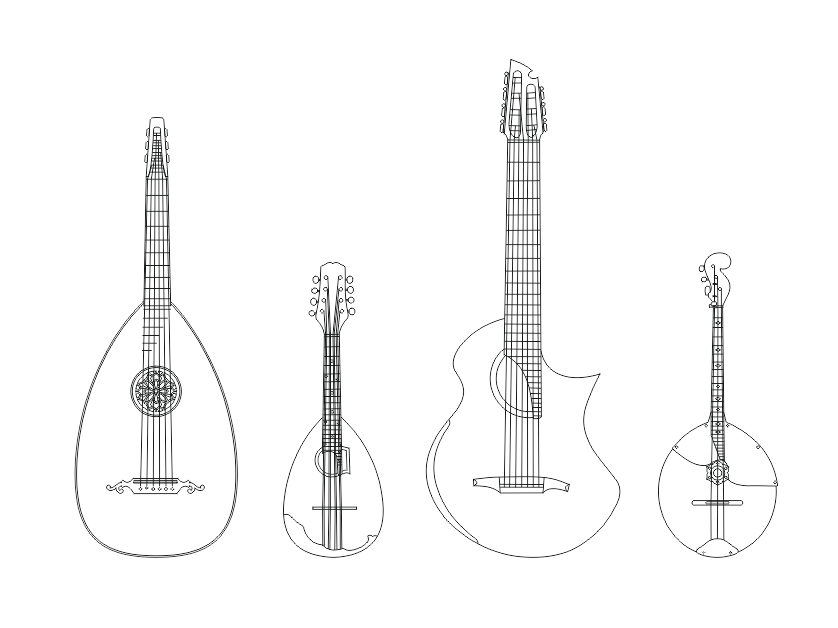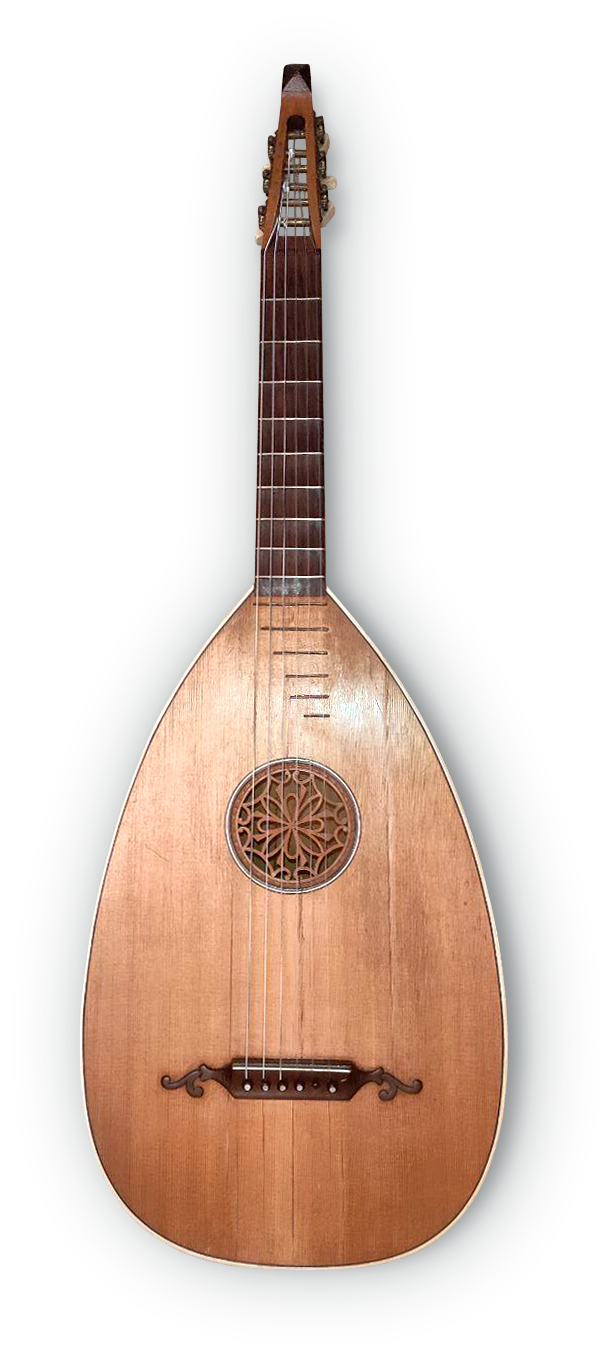The musicians are constantly working on their repertoire and creating their own arrangements. Renaissance and Baroque music, Impressionism, folk music as well as Latin American music of the 20th century are part of the duo's programme.
About duo
The duo was founded in 2011.
Evgenia Markova started playing music at the age of six. The first time she went to a music school to choose an instrument, she heard the domra and immediately fell in love with it.
After graduating from music school in 2002, she entered the St. Petersburg Music College and then continued her studies at the St. Petersburg Conservatory (Academy) named after Rimsky-Korsakov. She graduated in 2012.
After graduating from music school in 2002, she entered the St. Petersburg Music College and then continued her studies at the St. Petersburg Conservatory (Academy) named after Rimsky-Korsakov. She graduated in 2012.
Vladimir Kirasirov has been playing music since the age of 4. He started taking piano lessons from his mother and then entered a music school. Besides the piano, he was interested in other musical instruments, especially the guitar.
In 2002 Vladimir entered the St. Petersburg Musical Lyceum, then - the St. Petersburg Conservatory (Academy) named after Rimsky-Korsakov.
After finishing his studies in St. Petersburg in 2011, Vladimir entered the Maastricht Conservatory in the class of Carlo Marchione. After two years he obtained his Master's degree in the Netherlands
In 2002 Vladimir entered the St. Petersburg Musical Lyceum, then - the St. Petersburg Conservatory (Academy) named after Rimsky-Korsakov.
After finishing his studies in St. Petersburg in 2011, Vladimir entered the Maastricht Conservatory in the class of Carlo Marchione. After two years he obtained his Master's degree in the Netherlands
Evgenia and Vladimir often participate as guest artists in concerts of other musicians from different countries and collaborate with opera singers.

During their years together, Vladimir and Evgenia have performed in the Netherlands, Germany, Austria, Belgium, Latvia, Lithuania, Estonia, Finland, Croatia, Ukraine, Armenia, Slovenia, Russia and India, both as a duo and in collaboration with local ensembles.

They are first prize winners of the "Golden Key" competition (Boston, USA), participants in international festivals and charity music projects.



i
i
i
i
Coming concerts
15 Dec
Christmas songs and carols, folksongs, music that people play and listen to at this time of the year
Beegden, NL
Christmas episodes
Tickets & info
17 Dec
Christmas songs and carols, folksongs, music that people play and listen to at this time of the year
Herkenbosch, NL
Christmas episodes
Tickets & info
19 Dec
Christmas songs and carols, folksongs, music that people play and listen to at this time of the year
Maastricht, NL
Christmas episodes
Tickets & info
You may subscribe to our Telegram to not miss the news
No performances have been scheduled yet.


You may subscribe to our Telegram to not miss the news
No performances have been scheduled yet.


You may subscribe to our Telegram to not miss the news
No performances have been scheduled yet.


Concert programs
The concert program includes
Evgenia Markova and Vladimir Kirasirov – will present works by Baroque authors, music by French impressionists, and folk music from different countries in their own interpretation.
Press release
Guitar
used in program
used in program
Domra
used in program
used in program
Longing for baroque
A special feature of the concert is the use of a unique instrument "Wanderfogel", which was presented to the musicians by grateful listeners in the Netherlands. The instrument has a pear-shaped body borrowed from the mandora and six strings tuned like a guitar. The instrument owes its birth to the eponymous German youth movement Wandervogel (German: "Migratory Birds"), which existed from 1890 to 1936. The ideology of "migratory birds", close to the performers, permeates the entire concert programme.
Henry Purcell
Domenico Scarlatti
Johann Sebastian Bach
Jean-Philippe Rameau
Domenico Scarlatti
Johann Sebastian Bach
Jean-Philippe Rameau
Francois Couperin
Claude Debussy
Gabriel Faure
Béla Bartók
Claude Debussy
Gabriel Faure
Béla Bartók
Hicaz Mandıra (Turkish traditional)
Bulgarian Suite
Hungarian folk songs from Csik
Bulgarian Suite
Hungarian folk songs from Csik
The program includes arrangements of Balkan, Scandinavian, Central Asian, Arabic and oriental folk music from different countries. All arrangements are made by members of the group or by composers of the 20th century.
The concert program includes
Press release
Folk around the world
Guitar
used in program
used in program
Domra
used in program
used in program
Mandolin
used in program
used in program
The concert program includes
The musicians will present works of the Western European Renaissance, as well as Turkish, Arabic and South Slavonic folk music of the XV-XVII centuries in bold, original arrangements that will make the listener feel the closeness and difference of epochs and styles. The programme will also include author's compositions by the concert participants.
Press release
Guitar
used in program
used in program
Domra
used in program
used in program
Longing for Renaissance
Diego Ortiz
William Byrd
Hugh Aston
William Byrd
Hugh Aston
Tarquino Merula
John Dowland
Jacob van Eyck
John Dowland
Jacob van Eyck
Reynaldo Hahn
Maurice Ravel
Claude Debussy
Johann Sebastian Bach
Maurice Ravel
Claude Debussy
Johann Sebastian Bach
Chansons grises
The concert program includes
Guitar
used in program
used in program
Press release
Domra
used in program
used in program
Wandervogel
used in program
used in program
The cycle of songs by the French composer of the 19th and first half of the 20th centuries Reynaldo Hahn to poems by Paul Verlaine, Chansons grises, is the title of the concert programme. The concert programme will also include music by Maurice Ravel, Claude Debussy and Johann Sebastian Bach.
Mandolin
used in program
used in program
The performers of the programme are musicians from St. Petersburg, laureates of international competitions Lyubov Petrova (soprano), Evgenia Markova (domra, mandolin) and Vladimir Kirasirov (guitar, Wandervogel).
Lyubov Petrova is a guest soloist at the Bolshoi Theatre of Russia and the Metropolitan Opera.
The concert program includes
The concert programme includes original arrangements of music of the "impressionists" – Claude Debussy, Gabriel Fauré, Maurice Ravel, Spanish music of the 20th century – Manuel De Falla, Federico Mompou; early music – John Dowland and mystifications of early music – Vladimir Vavilov, as well as folk music in the version of 20th century composers – Béla Bartók.
Press release
Guitar
used in program
used in program
Domra
used in program
used in program
Impressions
Gabriel Faure
Claude Debussy
Bela Bartok
Federico Mompou
Claude Debussy
Bela Bartok
Federico Mompou
Maurice Ravel
Heitor Villa-Lobos
Egberto Gismonti
Heitor Villa-Lobos
Egberto Gismonti
Duo instruments

Tickets & info


The instrument was purchased in St. Petersburg, when Evgeniya entered the music school. The warm and relatively matte timbre of the domra immediately came to the young artist's liking and, to a great extent, influenced the formation of her performance technique.
The instrument is made by the master by order of Vladimir. Additional bass string is added to expand the range of the instrument. The design of the instrument is the master's idea.
Domra
Guitar
Master
Production
Construction
Construction
Evgeny Grachev
2019, Lithuania
3 strings: E – A – D
7 strings: B – E – A – D – G – B – E (Mexican or Brazilian tuning)
Production
Master
1956, USSR
Max Cuker
Wandervogel
Unknown
Master
3 strings: E – A – D – G – B – E
The instrument was presented to Vladimir by grateful listeners and the Netherlands – John and Manon Machiels. Wandervogel – an instrument created at the turn of the 19th and 20th centuries in Germany is a hybrid of guitar and lute. This instrument owes its birth to the eponymous German youth movement Wanderfogel (German for "Migratory Birds"), which existed from 1890 to 1936.
Construction
Approximately 1900, Germany
Production

4 double strings: G – D – A – E
The instrument was purchased when Eugenia decided to expand the horizons of her musicality and to immerse herself more in Western European repertoire.
Mandolin
Unknown
1970, Germany
Master

Construction
Production
The guitar has a long history dating back to ancient civilisations, and emerged in Spain in the 16th century. It has become one of the most popular and versatile musical instruments, used in many different styles. The Brazilian seven-string guitar is an acoustic guitar used primarily in choro and samba, introduced to Brazil in the late 19th century. It is typically tuned like a classical guitar, but with an additional C, B or A below the low E. The special design of this particular instrument was invented by a luthier - Max Cuker.
The domra is a traditional Russian, Ukrainian, and Belarusian plucked-string instrument that originated in the Middle Ages. It has a round body and three or four strings, picked with a plectrum and known for its tremolo sound. The three-stringed domra is traditionally used in Russia, while the four-stringed domra is most common in Belarus and Ukraine. It was widely used by "Skomorokhi" in Russia in the 16th and 17th centuries, but disappeared after being subjected to persecution. The modern appearance of the domra was established in 1896 by Vasiliy Andreev and a family of orchestral domras was created in the early 20th century.
The Wandervogel, also known as the lute guitar or German lute, is a German instrument that resembles a Renaissance lute but has six strings and metal pegs like a guitar. It is tuned the same way as a guitar and was created by the German youth movement Wandervogel, which existed from 1890 to 1936. This movement played a significant role in reviving folk songs in wider German society. The neck of the lute guitar is similar to that of a modern classical guitar, but the fretboard design may be different, with the fretboard occasionally being scalloped. The instrument was common in Germany from around 1850 and has a regular six-stringed guitar setup on a lute bowl, with some variants having up to 11 strings.
The mandolin is a small, pear-shaped, plucked instrument that belongs to the lute family. It is an ancestor of the Arabic oud, which appeared in Spain in the 8th century during the Arab conquest of the Iberian Peninsula and then spread eastwards to other countries in Western Europe. The name mandolin (known since 1634) is a diminutive form of the word mandola (known since 1235), meaning it is a smaller instrument. Unlike the "baroque mandolin", the modern mandolin invented in the 18th century and improved in the 19th century, has metal strings and peg mechanics which increases the volume of the resonating body.
Contact




17 Dec
Write to us by any convenient way:
Herkenbosch, NL
Tickets & info

Stay in touch






